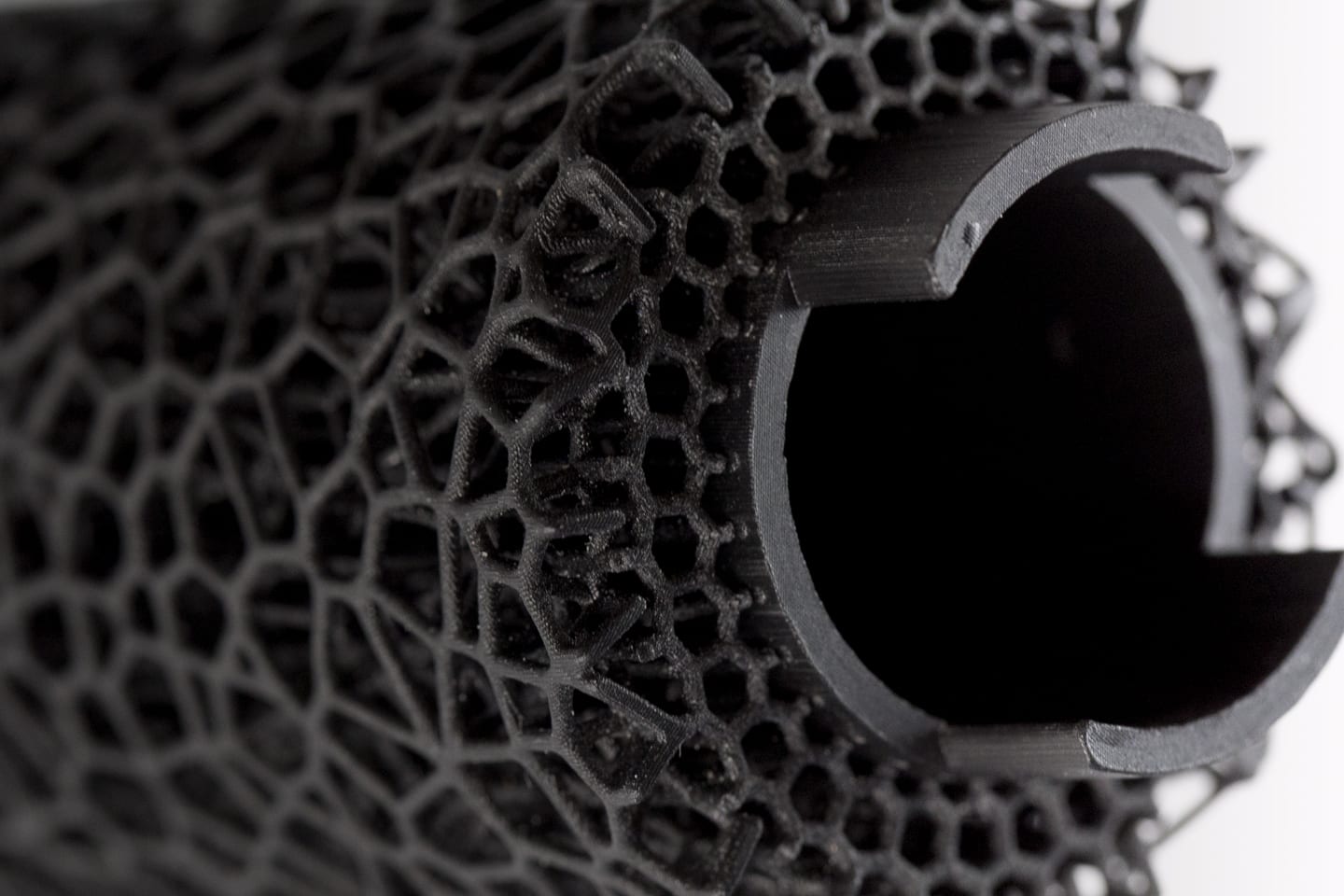

Originally published on fastradius.com on September 26, 2018
Elastomeric polyurethane (EPU) is a family of rubber-like materials developed by Carbon for Digital Light Synthesis™ (DLS) process. Similar to other elastomeric materials, EPU has a non-linear material response with a very high elongation to failure. This highly elastic material is suited for applications that require impact resistance or vibration isolation.
Carbon offers two different grades of EPU materials: EPU 40 and EPU 41. Although they have many commonalities, EPU 41 is slightly stiffer than EPU 40 and therefore has more shape rigidity, even under constant cyclic loading. However, the stiffer EPU 41 has a much lower elongation to failure, which means it’s more prone to fracture at higher strain. Both EPU 40 and 41 are perfect materials for integration of a compliant lattice structure, where the structure can be optimized or locally tailored for your given application requirements.
EPU 40 mechanical specifications
Ultimate tensile strength: 7.7 MPa
Elongation at break: > 250%
Tear strength: 23 kN/m
Stress at 50%: 1.9 MPa
Stress at 100%: 3.0 MPa
Read the Carbon® EPU 40 technical data sheet for more details.
EPU 41 mechanical specifications
Ultimate tensile strength: 6.2 MPa
Elongation at break: > 130 %
Tear strength: 20 kN/m
Stress at 50%: 2.7 MPa
Stress at 100%: 4.7 MPa
Read the Carbon® EPU 41 technical data sheet for more details.
The most obvious difference between EPU 40 and 41 is the natural coloring; EPU 40 is a standard black while EPU 41 is a distinctive linen green. Both EPU 40 and 41 can replace traditional elastic materials while providing good energy dissipation and compliance. Although the two are fairly similar, the details of your application might make one material advantageous over the other.
EPU 40
EPU 40 is Carbon®’s original EPU material. The lower stiffness provides a more compliant structure that is well suited for applications that require dampening, energy dissipation and shock absorbance. Additionally, the high elongation to failure means that it can recover from very large deformations.
However, due to the natural black coloring, parts printed with EPU 40 limits the color aesthetic options.
EPU 41
EPU 41 is Carbon®’s latest addition to its EPU family. It’s a production-grade elastomeric material with higher rigidity and resilience (energy return) than EPU 40. EPU 41’s rigidity allows you to push the limits on part complexity because parts can be made from more intricate structures like lattices.
Generally speaking, parts printed with EPU 41 have a smoother surface finish and require less post-processing, making them ready for customer-facing applications.
EPU materials lend themselves well for applications that demand abrasion resistance, tear strength, chemical resistance and temperature compatibility.
Combined with the unique ability of both EPU 40 and 41 to create functional lattice structures, they can accommodate designs for demanding applications such as:
EPU 40 is great for dampening lattices — making it a perfect fit for industrial applications, such as robotics, industrial tooling and intermittent loading which require shock absorption. Lattices consisting of EPU 41, on the other hand, have greater resiliency and is well-suited to applications with an interface that require a certain “feel” or tactile element in which energy return is desired.
SyBridge can tune the hardness of EPU lattices to achieve different performance attributes in different regions of a part for enhanced functionality and heightened user comfort, as was the case when we worked with Steelcase to redesign an arm cap on their award-winning SILQ chair.
Carbon® designed EPU 40 and 41 specifically for its DLS process, meaning both can undergo the continuous liquid interface process (CLIP) to print production-grade isotropic parts.
Design and operational considerations
There are three main design considerations to keep in mind when designing parts with EPU 40 and 41: Overhangs, vacuums and part size.
Both materials come with an overhang angle limitation of 45 degrees; anything over that will require support material. In addition, vacuums need to be meticulously designed out of your part to prevent air from being trapped. Also, it’s important to keep your part size at a minimum feature height to prevent long print times. The key operational consideration here is ensuring there’s a flat surface for the layers to sit on and accept sacrificial supports.
A secondary operational consideration is EPU 40 and 41’s pot life. Both materials can only run through the DLS process within the timeframe of their respective pot lives, or how long they’re workable after being catalyzed. The pot life for EPU 40 is slightly shorter than that of EPU 41. So, if your part is fairly large, then using EPU 41 may be preferable.
EPU 40 and 41 can work within our standard lead time of five to seven business days — two for expedited orders or smaller builds. Depending on the size and shape of your part, printing can take anywhere from several minutes to 12 hours.
Parts made with either material will require a 10-minute wash and an eight hour or less thermal cure.
Brainstorm the constraints of your application before you select a material. If you’re looking at an industrial application, then EPU 40 could be a good fit. But, if you’re seeking a specific color aesthetic, then EPU 41 might be the better choice.
Before you choose between EPU 40 and 41, we encourage you to contact our team to discuss each option.
Forget typical cycle times. We're pushing the boundaries of conformal cooling. While traditional approaches deliver…
Forget typical cycle times. We're pushing the boundaries of conformal cooling. While traditional approaches deliver…
From left to right: Brayden Janak (apprentice); Logan Vifaquain (CNC machining, Programming and CMM); Ron…
SyBridge Technologies is proud to announce we have been awarded the 2023 General Motors Supplier…
Today, designers and engineers are accustomed to working with digital tools in their day-to-day jobs.…
Optimizing Your Injection Molding Process for Cost-Effective Manufacturing Excellence In today’s competitive landscape, manufacturers are…